Just because the summer season is about to end doesn’t mean you cannot grow something beautiful in your yard.
You can still grow some colorful flowers in your garden during the fall season until the first hard frost.
But what flowers do well during the fall?
This article will discuss 16 flowers that do well in the fall.
African Daisy
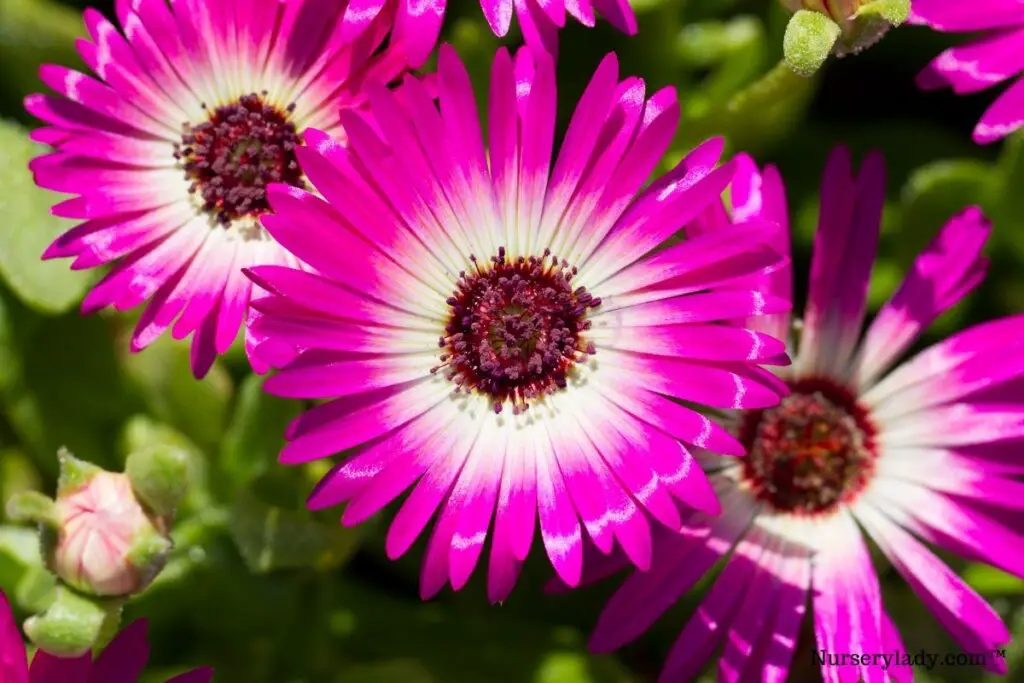
African Daisy produces beautiful blooms with center disks giving a metallic paint look with petals around it.
Their leaves are lance-like, broad, smooth, or loved depending on the variety. They grow rapidly and bloom in two to three months of sprouting and in fall.
Light: African daisies like full sun exposure and can tolerate partial shade. Their blooms open in light and close at night. In low light, the growth and bloom will reduce.
Watering: African daisies need proper water when it is young. Once established, they become drought-tolerant. Thought watering when the soil is dry will encourage better blooming. Never keep the soil soggy as it can lead to fungal diseases.
Fertilizer: African daisies are heavy feeders, and you can feed them with balanced fertilizer by diluting to half the strength throughout the growing season. They will also appreciate adding compost into the soil to keep the soil nutrient-rich.
General care: African daisies can tolerate night temperatures below 40°F. Keep them near radiators, fireplaces, vents during first to give them some warmth. Average humidity is one, but good air circulation is just for optimal health.
Petunias
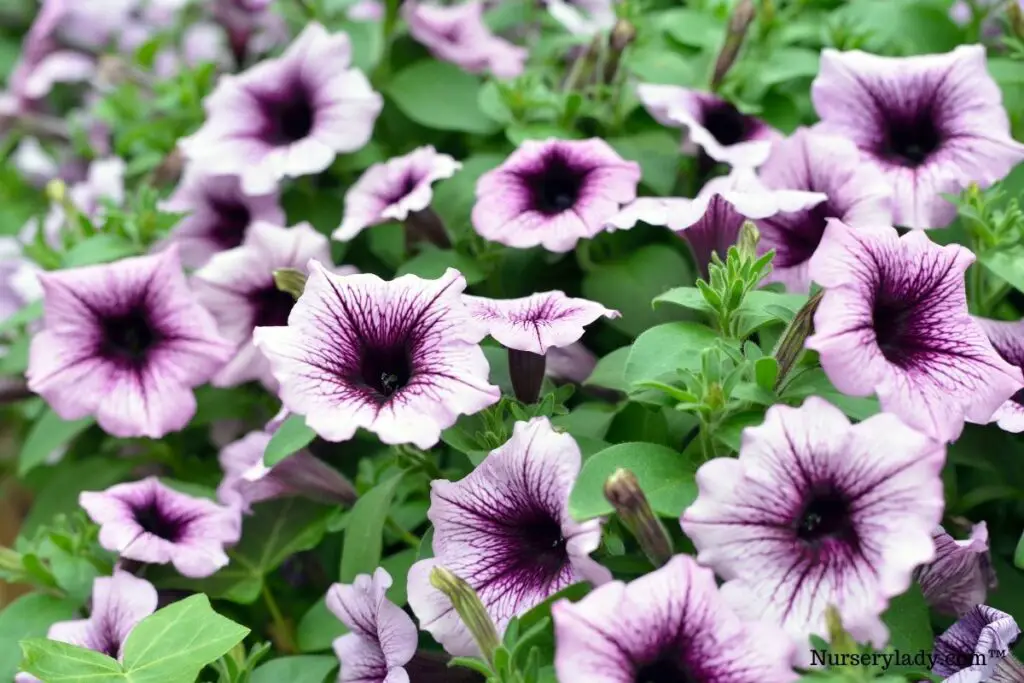
Petunias flowers in almost all colors, trumpet-shaped, and cascades beautifully in containers, hanging baskets, and ground beds.
The foliage is hairy and sticky, and they are fast-growing and bloom in fall with some fragrance.
Light: Petunias like full sun exposure, i.e., 6-8 hours of direct light in a day. Win hot summer keep them in partial shade to protect them from harsh sun rays.
Watering: Petunias likes to be watered but doesn’t appreciate sitting in water. This can lead to root rot fungal problems, legginess, and reduced flowering. Water them when the soil is halfway dry and avoid long dry periods.
Fertilizer: Petunias can be fed while planting with a balanced fertilizer. Feed them from July till the plant declines with balanced flowering fertilizer once every month. Avoid over-fertilizing and check your plant food needs as they may differ from variety to variety.
General care: Petunias performs best in temperature levels ranging between 60°F to 75°F. They can bear temperatures below 40°F, but frost can damage or even kill them. They prefer low to average humidity.
Bidens
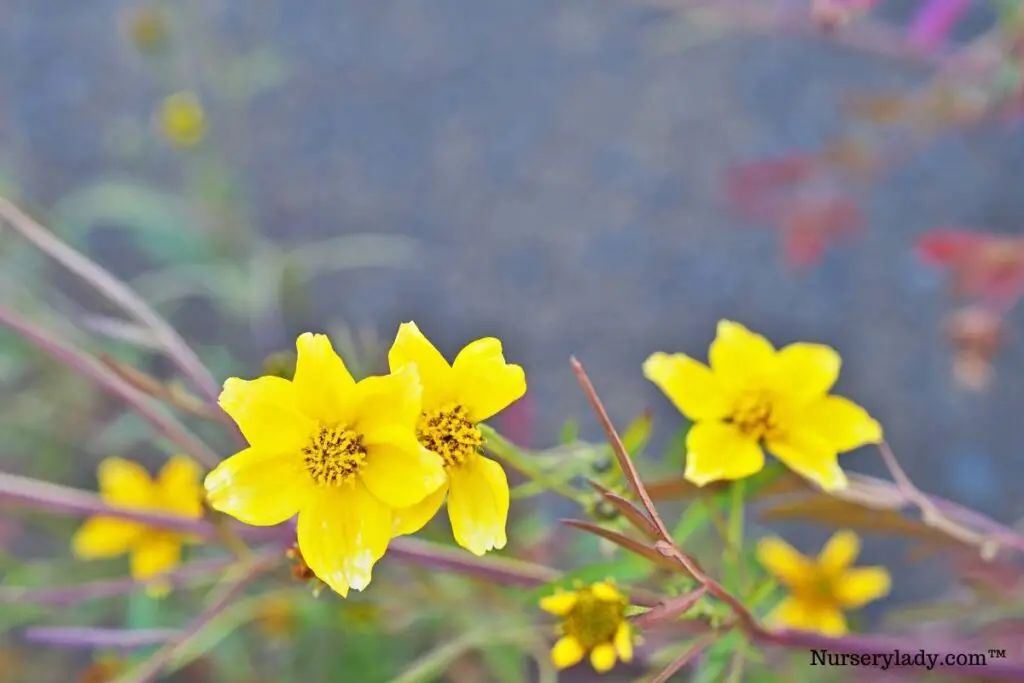
Bidens are beautiful bright fall flower plants. They grow well in containers, beds looking great with their trails and Daisy-like blooms.
Their foliage stays green throughout the year. Different varieties bloom in different colors like pink, gold, orange, white, etc.
Light: Bidens can grow from full sun to partial shade but prefers full sunlight. In the direct sun, they will produce better and bigger blooms. If they receive less light, the blooms will be less and stem leggy.
Watering: Water Bidens when the soil is dry, are quite drought-tolerant. They do not need frequent watering, but regular watering will lead to better health and longevity. Ensure proper drainage and water before the plant starts wilting.
Fertilizer: Bidens appreciate nutrient-rich soil as it helps them stay healthy and produce abundant flowers. You can feed them with balanced diluted fertilizer or time-release fertilizer while planting. Feed once in the growing season, especially if growing them in containers.
General care: Bidens like warm temperatures and may suffer in high heat and humidity. Though some of its varieties are heat tolerant too, keeping them in dry conditions for a prolonged period can make them uncomfortable.
Blanket flower
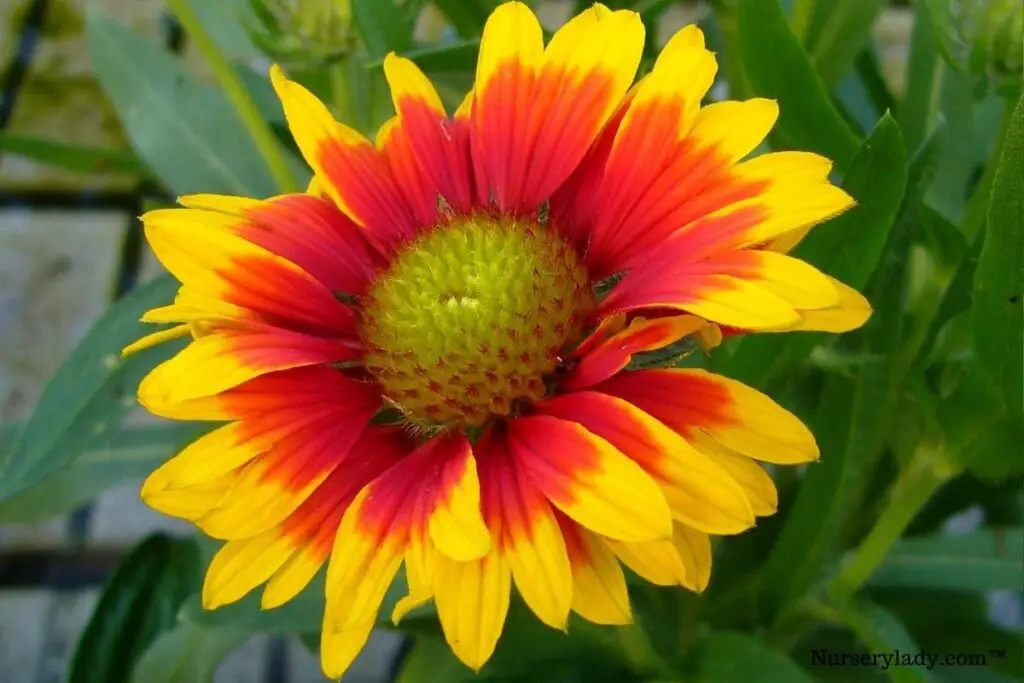
The blanket flower produces large daisy-like flowers in colors like red, yellow-orange. They spread like a blanket due to which name is given.
They are fast-growing and look amazing in containers, hanging pots due to their trailing habit.
Sunlight: Blanket flowers grow abundantly in abundant light. They can grow in partial shade too, especially in hot summer, but the flowering will be less abundant in low light.
Watering: Water blanket flowers in the first season properly to encourage their root development. Check the soil before watering and ensure that excess water is draining out after watering. They are drought tolerant but will appreciate a drink in very dry conditions.
Fertilizer: Blanket flowers don’t need food, and they will grow well in poor soil and less in rich and fertilized soil. Simply avoid fertilizing and see your plant blooming abundantly.
General care: Blanket flowers like hot temperatures and humid conditions. They may not do that well in cool and misty weather, so it is recommended to add mulch to protect them in winter.
Looking for gardening supplies? We have tested 100's of products before recommending them to you guys. Check out our best pick below:
| Image | Gardening Supplies | Best Price? |
|---|---|---|
 Top
Top Top
Top | Raised Garden Bed Kit | Check On Amazon |
 | XLUX Soil Moisture Meter, Plant Water Monitor, Soil Hygrometer Sensor for Gardening, Farming, Indoor and Outdoor Plants, No Batteries Required | No Results |
 Top
Top Top
Top | 82 Pcs Garden Tools Set and Extra Succulent Tools Set | Check On Amazon |
 | Joeys Garden Expandable Garden Hose with 8 Function Hose Nozzle, Lightweight Anti-Kink Flexible Garden Hoses, Extra Strength Fabric with Double Latex Core, (50 FT, Black) | No Results |
 Top
Top Top
Top | Dual Chamber Compost Tumbler | Check On Amazon |
 Top
Top Top
Top | Sunnyglade Plant Stakes | Check On Amazon |
 Top
Top Top
Top | Organic Cold Pressed Neem Seed Oil | Check On Amazon |
 Top
Top Top
Top | Mighty Mint Gallon :-Insect and Pest Control Peppermint Oil | Check On Amazon |
 Top
Top Top
Top | Scotts DiseaseEx Lawn Fungicide | Check On Amazon |
 Top
Top Top
Top | Jacks Classic 20-20-20 All Purpose Fertilizer | Check On Amazon |
 Top
Top Top
Top | 30,000 Seeds Pollinator Attracting Wildflower Mixture | Check On Amazon |
 Top
Top Top
Top | Survival Vegetable Seeds Garden Kit-Over 16,000 Seeds | Check On Amazon |
Ageratum
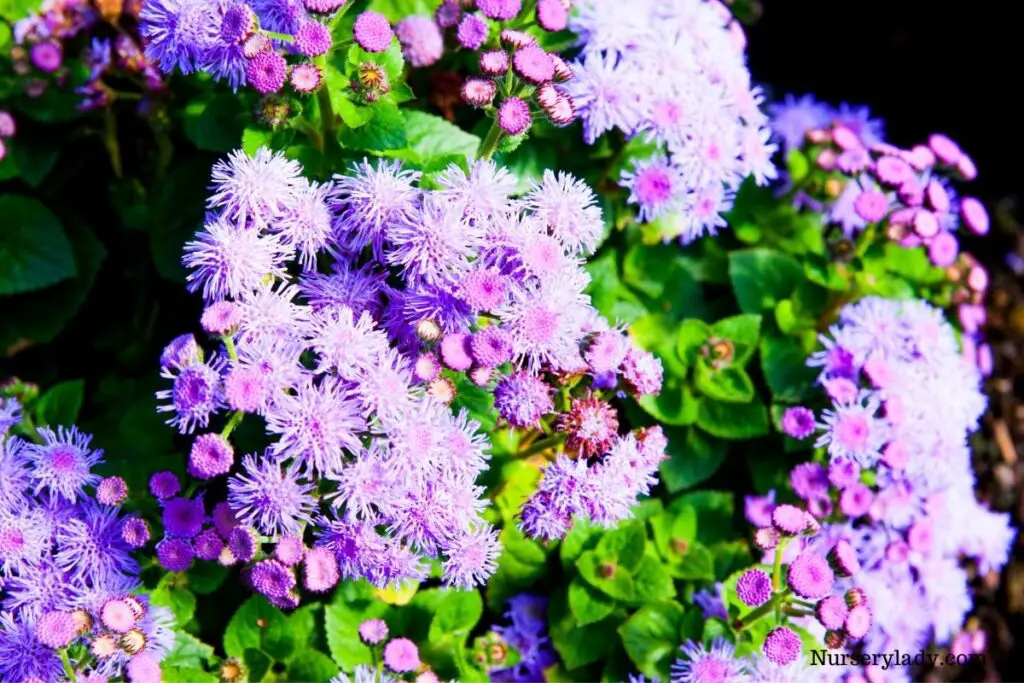
Ageratum has beautiful purplish-blue flowers, which now come in other colors too like pink, purple, white.
They look amazing as ground covers and can reach 30 inches tall. They generally bloom from spring till the first frost of fall, and some bloom even more than that.
Sunlight: Ageratum likes bright light and can be kept in full sun during a cool climate. They would appreciate some shade during hot summer, especially from the afternoon sun.
Watering: when ageratum is young, keep them evenly moist to establish strong roots. After that, it can withstand short periods of drought. Check the soil to avoid overwatering issues. Water them by soaking them deeply and avoiding overhead watering.
Fertilizer: Ageratum is a light feeder and asks for feeding only when the soil is poor. Feed them with a slow-release balanced fertilizer in the spring to promote blooming. If their leaves turn yellow, it indicates a lack of nutrients.
General care: Ageratum performs best in warm climates and low to average humidity, and high humidity can result in fungal diseases, root rot. They need good air circulation to stay healthy. Cut back growing tips of young ageratum for better flowering and deadhead spent flowers for continued blooms.
Chrysanthemums
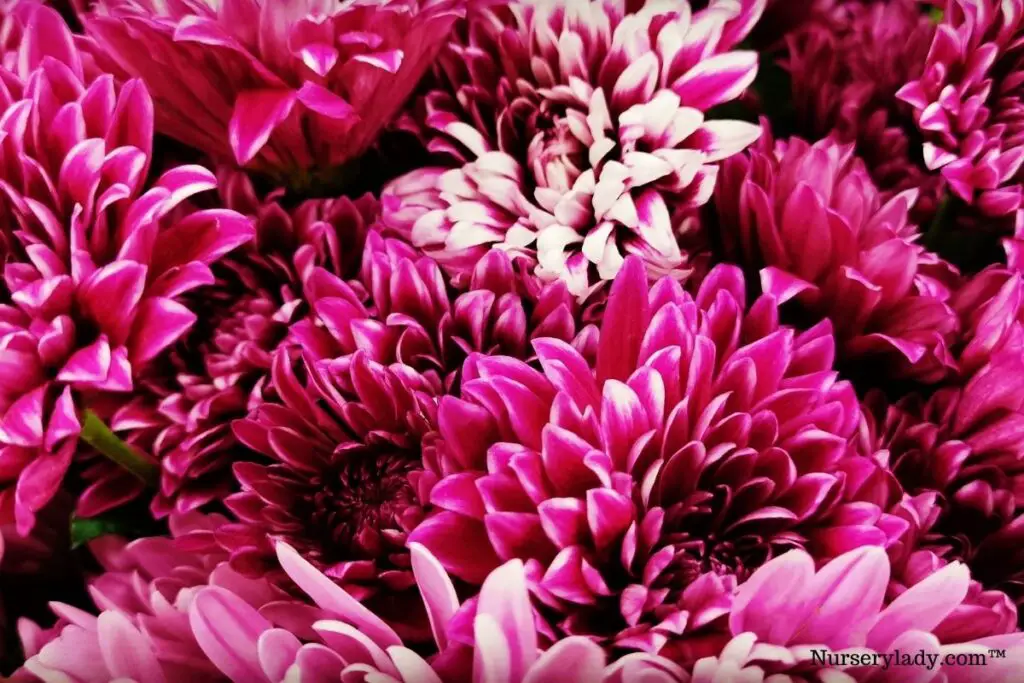
Chrysanthemums produce flowers in several colors like purple, pink, red, orange, white, and many more.
They bloom in fall when most of the summer plans fade. They are fast-growing and look great as ground covers, in containers, hanging baskets, etc.
Sunlight: Chrysanthemums perform best in full sun but can grow in the shade too. If the sun is too strong, they will appreciate some shade. Please keep them in bright light for 6 hours every day for abundant blooming.
Watering: Water your newly planted Chrysanthemums once every week and increase them as buds mature. Water-grown Chrysanthemums thoroughly till the excess water drains out of the drainage holes. Keep the soil evenly moist and avoid sogginess as it leads to root rot.
Fertilizer: Chrysanthemums can be fed before flower buds form to encourage strong roots. Feed them from March till July to promote new growth with high nitrogen and potassium fertilizer or simply feed once with a slow-release fertilizer that will feed Chrysanthemums for three months.
General care: Chrysanthemums like moderate environments. They struggle in high heat and also succumb to cold in freezing temperatures. They like humid conditions, but you must ensure proper air circulation to avoid fungal problems. Give some protection to its roots and crown by mulching during winter.
Calibrachoa
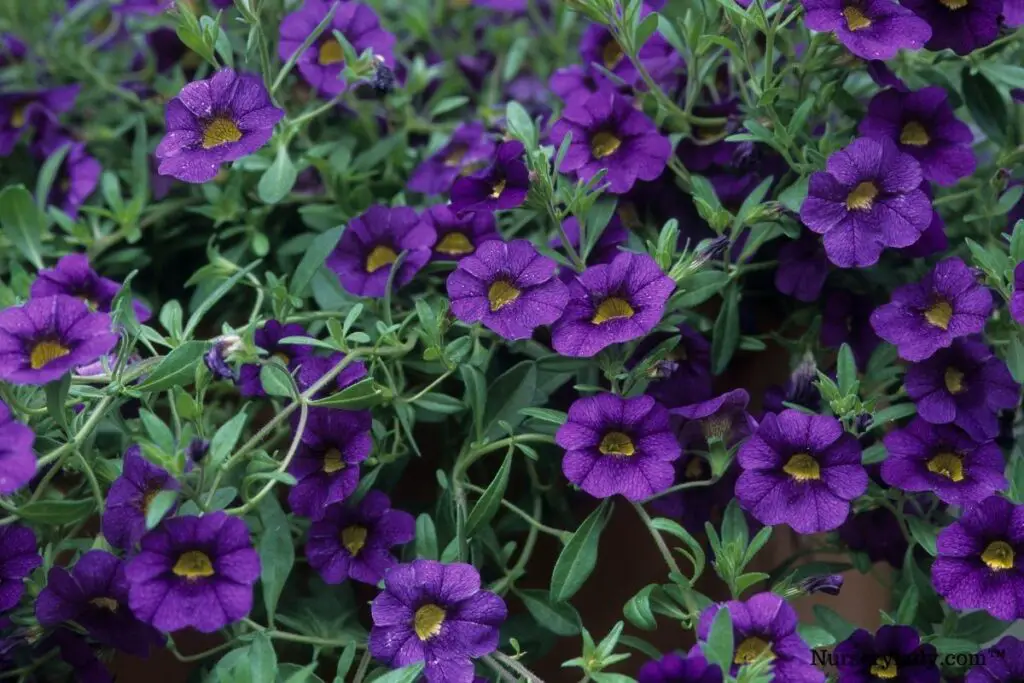
Calibrachoa is a popular plant with bell-shaped blooms in a rainbow of colors and patterns. Their leaves are oval and sticky.
They can flower from spring till frost and also attract hummingbirds, bees, butterflies. They grow well in containers, bowls, baskets and look beautiful with their trails.
Sunlight: Calibrachoa prefers full sunshine, at 6 hours of sun in a day yields the best blooming. It will appreciate some shade during hot summer months, but sufficient light is crucial for abundantly blooming.
Watering: Calibrachoa can be watered regularly, but make sure the excess water is drained out to avoid waterlogging. Check the soil by digging a finger in the soil from the top and feeling the soil. If the soil feels dry, give the plant a drink.
Fertilizer: feed calibrachoa with liquid fertilizer by diluting it to half the recommended strength. When planting, it feeds the plant with slow-release fertilizer to give them a nutrient boost in the beginning. Feed at the end of the season to help them bloom but avoid overfeeding.
General care: Calibrachoa is hardy plants, and they are heat-tolerant, cold tolerant, and drought tolerant. Maintain temperature levels between 55°F and 65°F for best blooms. During freezing temperatures, it is good to give them some warmth.
Nemesia
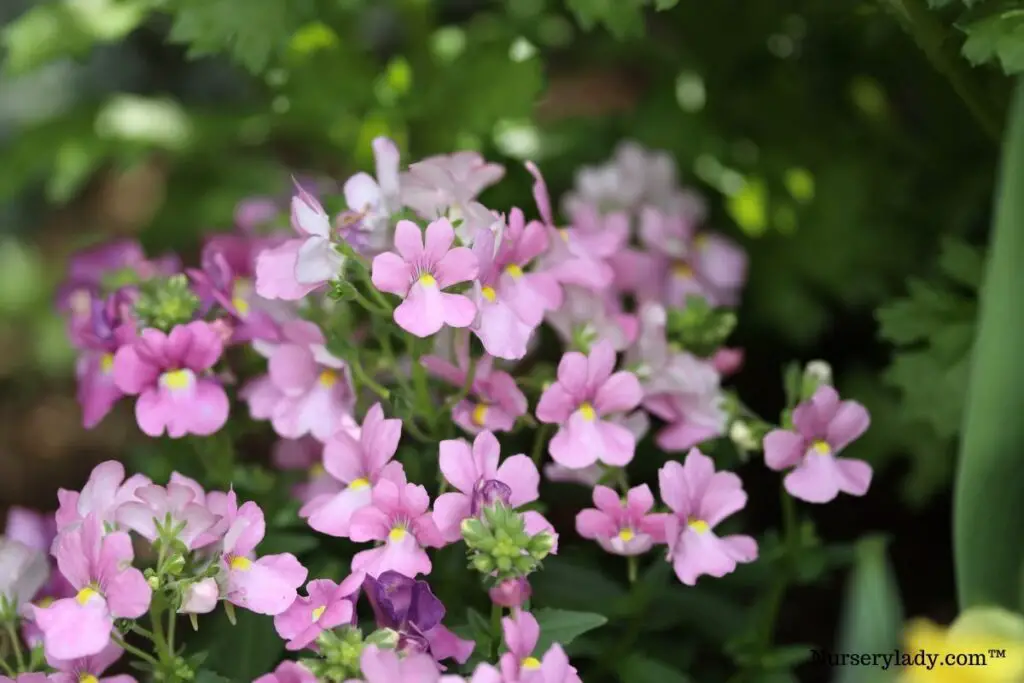
Nemesia has beautiful blooms resembling orchids that look great as ground covers, edging plants, hanging pots, etc., flowers are in a variety of colors, and some are even bi-color. Depending on the variety, they can grow up to 2 feet tall.
Light: Nemesia is a sun-loving plant and blooms better in good lighting. However, they will not mind some shade in the afternoon sun during hot summers.
Watering: Nemesia should be watered properly to keep its soil evenly moist, but sogginess should be avoided. It is better to check the soil’s moistness by digging a finger/skewer in the soil before watering, and it will help avoid over-watering as it leads to stem rot.
Fertilizer: Nemesia can be fed with a slow-release fertilizer once in the spring. You can also use water-soluble fertilizer once every month throughout the growing period.
General care: Nemesia prefers cool temperatures and struggles in hot temperatures. Add mulch to protect them from freezing winter temperatures. Cut off wilted flowers to promote more flower production.
Cannas
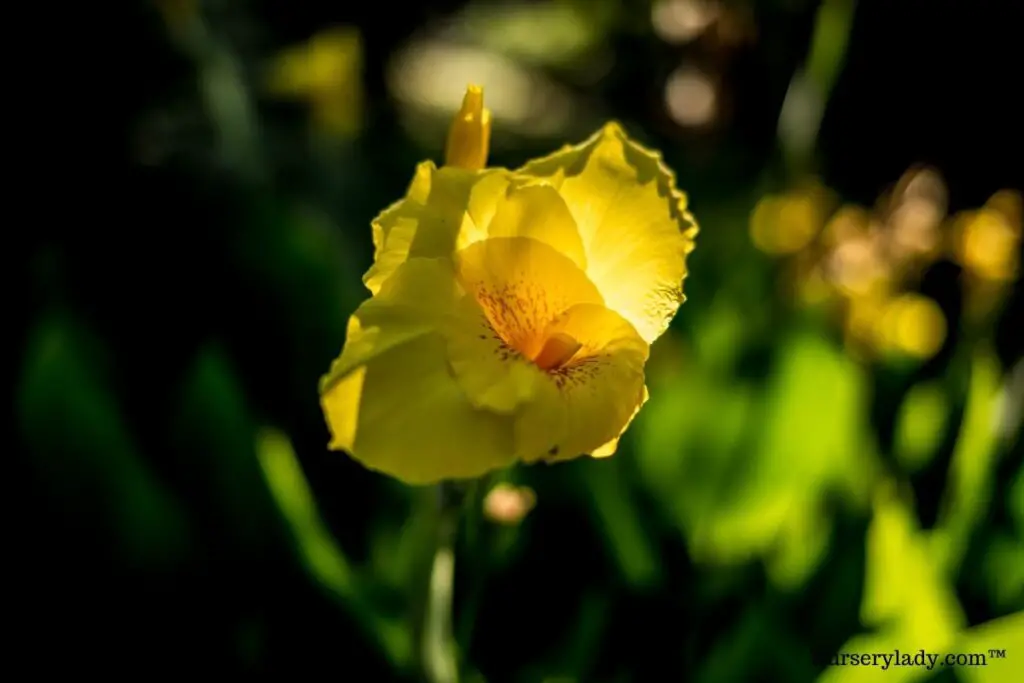
Cannas have huge leaves with a waxy coating and red, yellow, pink, orange flowers.
They are easy to grow, and flowers also attract bees, birds. They can grow up to 8 feet tall and bloom in the fall and ten stored overwinter.
Sunlight: Cannas to reduce vibrant blooms and textures leaves require full sunshine. They can grow in partial shade too but not as abundant as in the full sun. Ensure enough light to help the soil dry out easily.
Watering: Cannas can be watered in regular intervals ensuring that the soil is drying between watering. The soil should not be sitting in water for long, or you will soon find roots rotting and suffering due to fungal diseases.
Fertilizer: Cannas can be fed with organic fertilizer once every month throughout the growing period. Dilute the balanced food to half the recommended strength to avoid overfeeding. You can also work with compost to keep them happy and blooming.
General care: Cannas can thrive in high-temperature levels up to 90°F, and they will survive in cool temperatures, and the growth slows down. They do well in humid conditions, and misting can help in dry areas.
Phlox
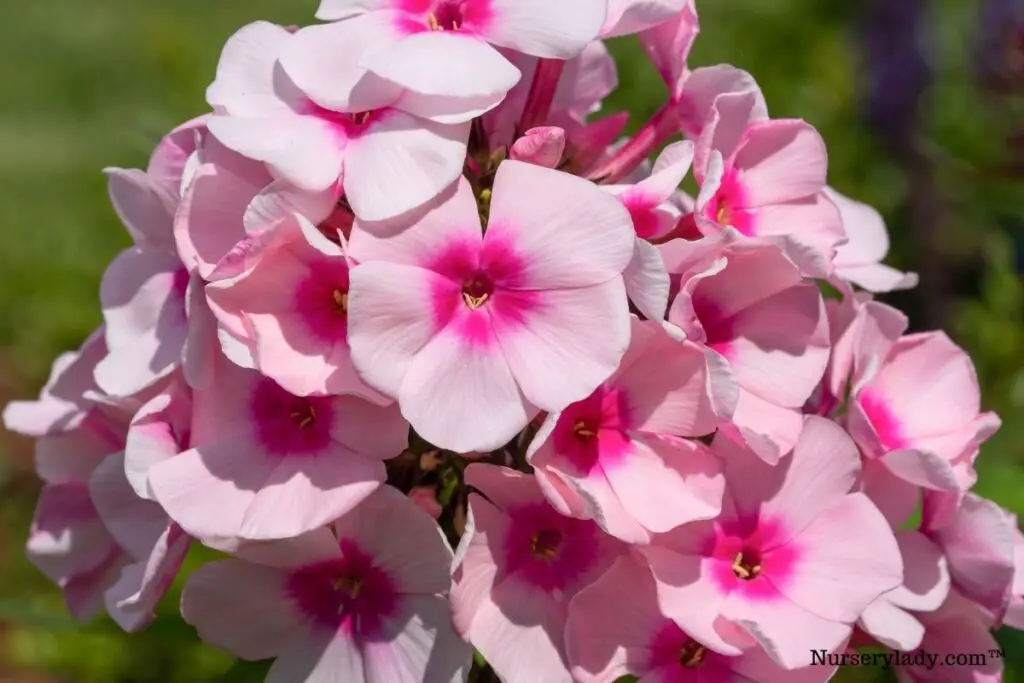
Phlox produce long flowers with mild fragrance in hues of purple-pink, orange, white, blue, or bicolor.
They bloom annually until frost and add beauty to your garden or space.
Light: Phlox grows and blooms best in full sun. In hot summers, give them shade to protect them from harsh sun rays, and low light will deter their blooming and growth.
Watering: Phlox does not appreciate soggy soil but likes to be watered properly to keep the soil evenly moist. Check the soil’s moistness before watering to avoid overwatering. Also, water directly at the soil and not from the top to avoid fungal problems.
Fertilizer: Phlox thrives in rich soil and can thrive without fertilizer in rich soil. Though, adding compost in the spring is sufficient for abundant blooming and growth.
General care: Phlox prefers hot and humid conditions. During cold weather, you can add mulch to the soil to help roots combat winter.
Salvia
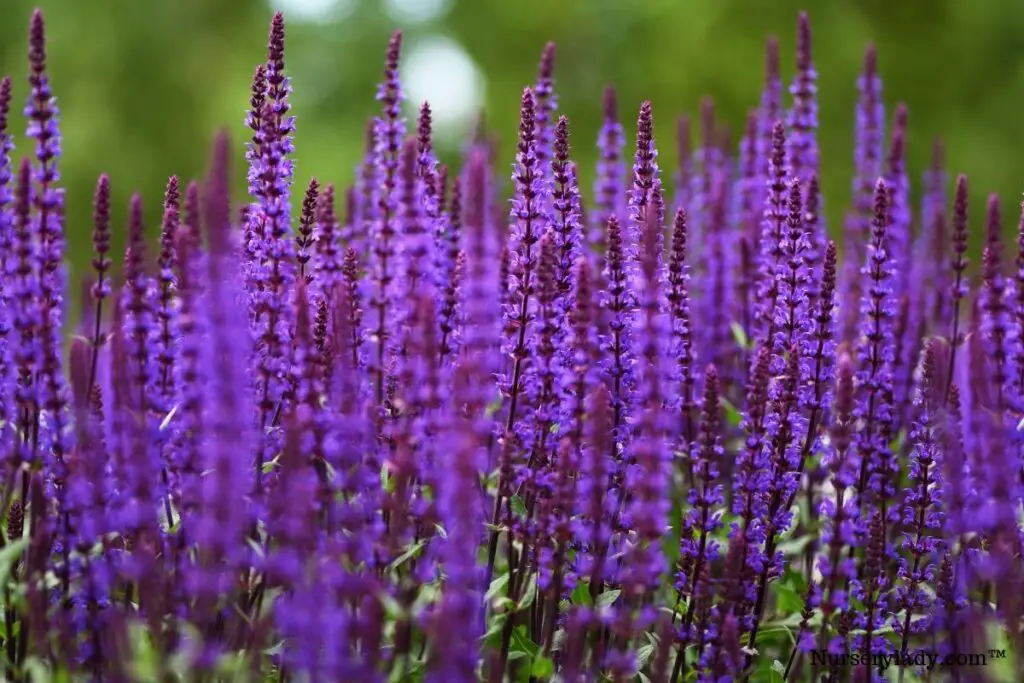
Salvia produces stunning flowers that look amazing when massed together in your garden.
They look great in ground covers, containers, and they will bloom from spring till fall if you care for them. They flower in colors like pink, purple, salmon, burgundy, lavender, orange, and white.
Light: Salvia grows and blooms best in a spot where it receives 6-8 hours of bright light per day. They will grow well in partial shade but need enough light to grow successfully.
Watering: Salvia can be watered every few days when the soil is halfway dry, and they need more frequent watering in hot summer temperatures. Keep the soil evenly moist but never overwater it.
Fertilizer: Feed salvia with balanced fertilizer by diluting to half the recommended strength once in the spring. They are light feeders, so avoid over-fertilizing as it will only reduce their blooms.
General care: Salvia thrives on varying temperature levels and may struggle with temperature fluctuations. They are frost-sensitive and suffer in temperatures below 32°F. Please keep them in warm areas during frost.
Strawflower
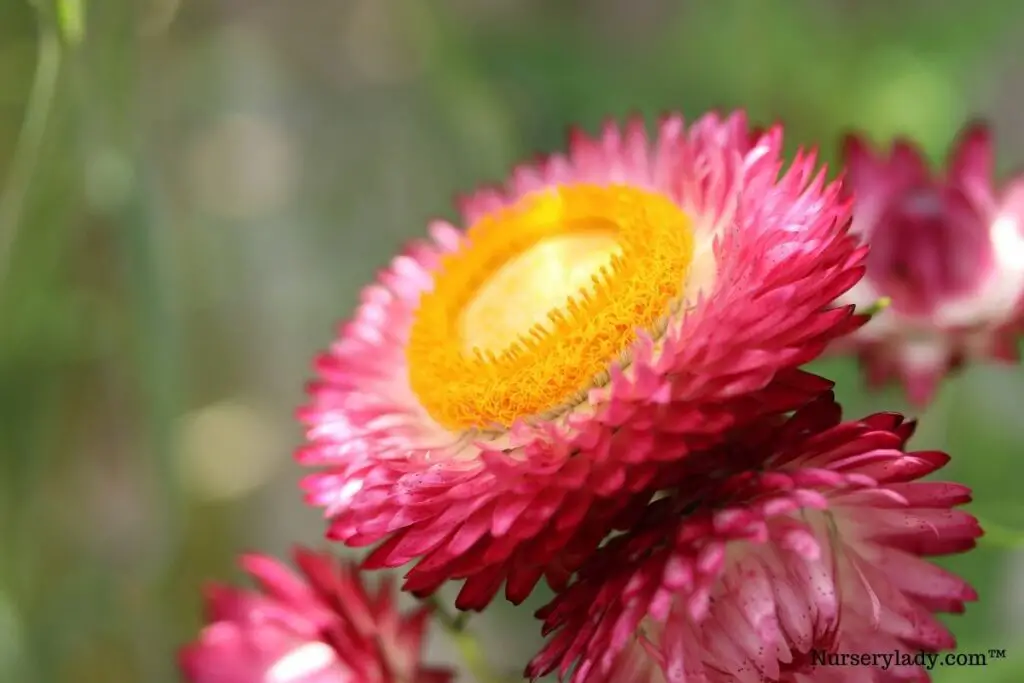
Strawflowers bring color to your garden, home. Their blooms are stiff, paper-like, and have silvery leaves.
They can grow up to 3feet tall, which might need stakes to stay upright.
Light: Strawflower blossoms in full sun but can grow in partial shade too. In the shade, they may not be blooming as abundantly as they would in sunny locations. Also, good lighting will keep the plant strong and healthy.
Watering: Water strawflower when the soil is halfway dry. They are drought tolerant and can bloom in dry weather too. Giving them a drink and keeping the soil evenly moist will keep the plant happier.
Fertilizer: Strawflowers are light feeders and can do well without feeding. If you wish, you can add a balanced fertilizer in the growing season, which will also encourage blooming. If they are growing in containers, then they ask for more fertilizing than those in the garden.
General care: Strawflower blooms best in temperatures ranging between 65°F and 70°F. They need low humidity and may suffer in high humidity. Please keep them in warm conditions in freezing temperatures and add mulch to help plants tolerate frost.
Sweet alyssum
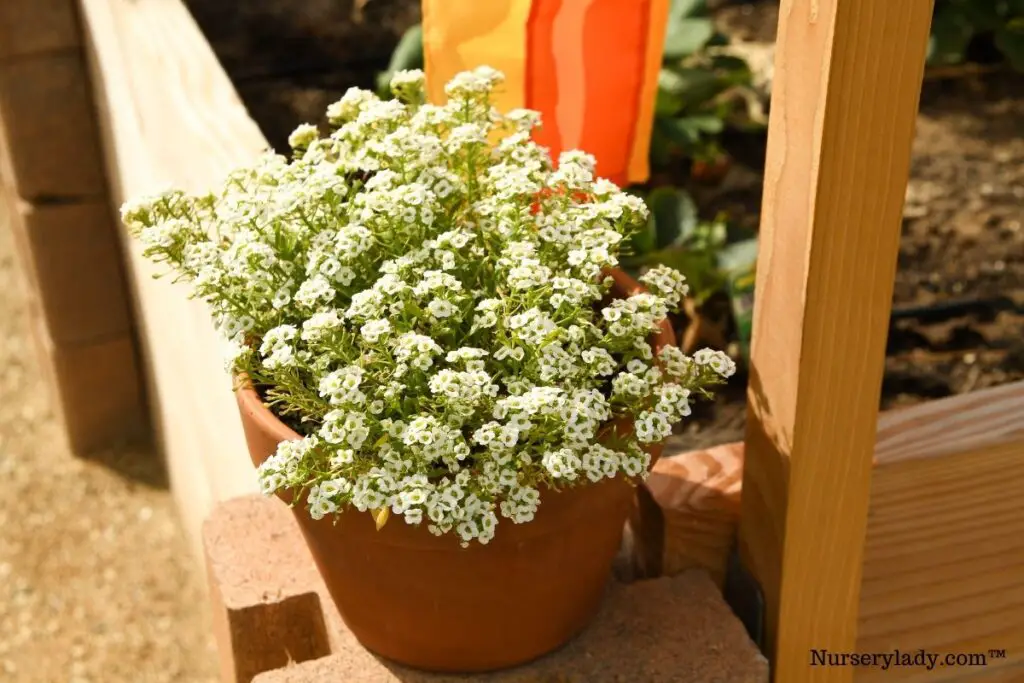
Sweet alyssum produces fragrant blooms in several colors like pink, purple, peach, white, etc. They spread slowly and look stunning in pathways and borders.
It has hairy, narrow gray-green foliage. They grow throughout spring, fall and winter, and they might fade due to hot summer but will bloom back in fall.
Light: Sweet alyssum grows well in full sun but appreciates some shade in dry, hot weather. Give them enough light to allow the soil to dry out easily.
Watering: Sweet alyssum prefers watering in regular intervals during hot days, and they need water to stay moist and not soggy. The excess water should drain out, and you should check soil moisture before watering to avoid overwatering.
Fertilizer: Sweet alyssum can thrive even without any feeding, provided the soil mix is fertile. If the soil is poor, feed them with balanced fertilizer by diluting it to half the recommended strength. Feed them again when the blooms are spent to encourage new growth and blooms.
General care: Sweet alyssums are heat-sensitive and may stop blooming in heat. They can thrive in high humidity too, provided soil should not be kept soggy. Keep pruning to keep the plant near and in shape and encourage better growth.
Verbena
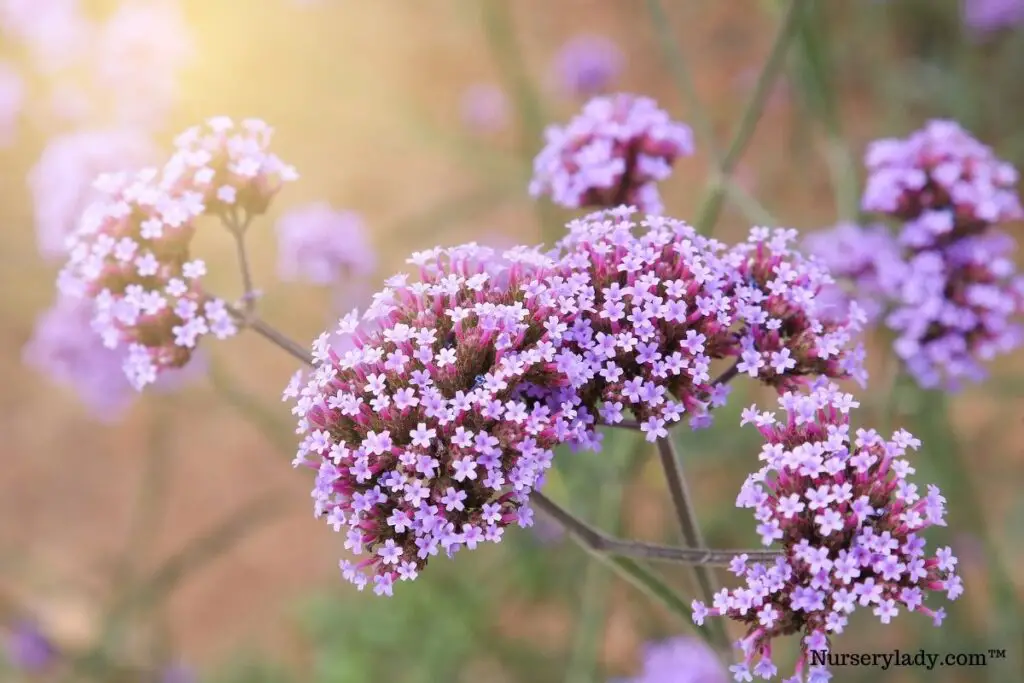
Verbena is widely grown as bedding plants, or in containers due to their trailing habit.
They are fast-growing and easy to care for, and they mature rapidly and bloom in fall too. They flower in colors like purple, pink, peach, and white.
Light: Verbena is a sun-loving plant and requires at least 8 hours of sun exposure daily
for best blooms. In the shaded area, they will grow and bloom in low light but not as abundantly as in the full sun.
Water: Verbena likes its soil evenly moist. They need water to stay moist but can tolerate short periods of drought. The best way to water them is by giving an inch of water every week to keep the soil evenly moist.
Fertilizer: Verbena being light feeders, appreciate monthly feeding with slow-release balanced flower food. This will encourage blooming and also increase their bloom time until frost.
General care: Verbena is hardy and can survive in any climate. They may struggle in too hot weather and need some protection from the direct sun. They prefer low to average humidity.
Black-eyed Susan
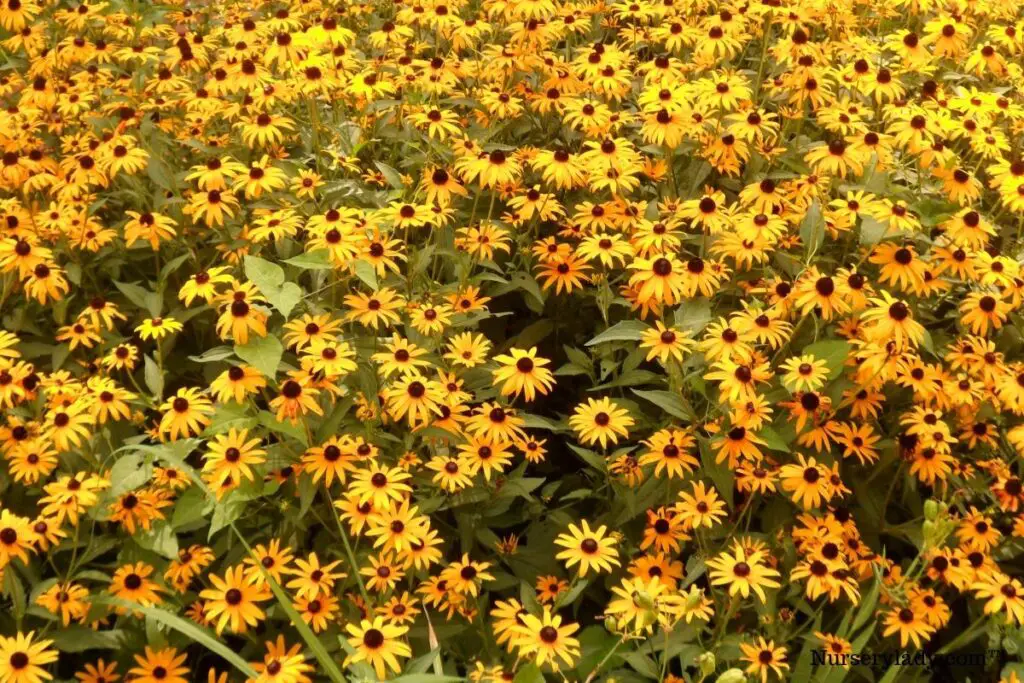
Black-eyed Susan produces bright flowers with dark centers that attract many pollinators.
They will beautify your space, whether planted in the garden or in containers inside the home. It blooms from summer till fall and is known for its invasiveness in many areas.
Light: Black-eyed Susan can grow well in full sun and part shade. They appreciate some shade during the afternoon sun in hot summers.
Water: water black-eyed Susan regularly to keep the soil evenly moist. Check the soil’s moistness; if the soil feels moist to touch, then wait for it to dry before watering. Wilting signifies the need for water. Water thoroughly and let the excess water drain out.
Fertilizer: Feed black-eyed Susan with a balanced flowering fertilizer monthly during their blooming season. Always dilute the recommended strength to half to avoid over-watering.
General care: Black-eyed Susan prefers warm and humid conditions. They are quite hardy to unfavorable conditions but may suffer in hot, dry weather.
Sunflower
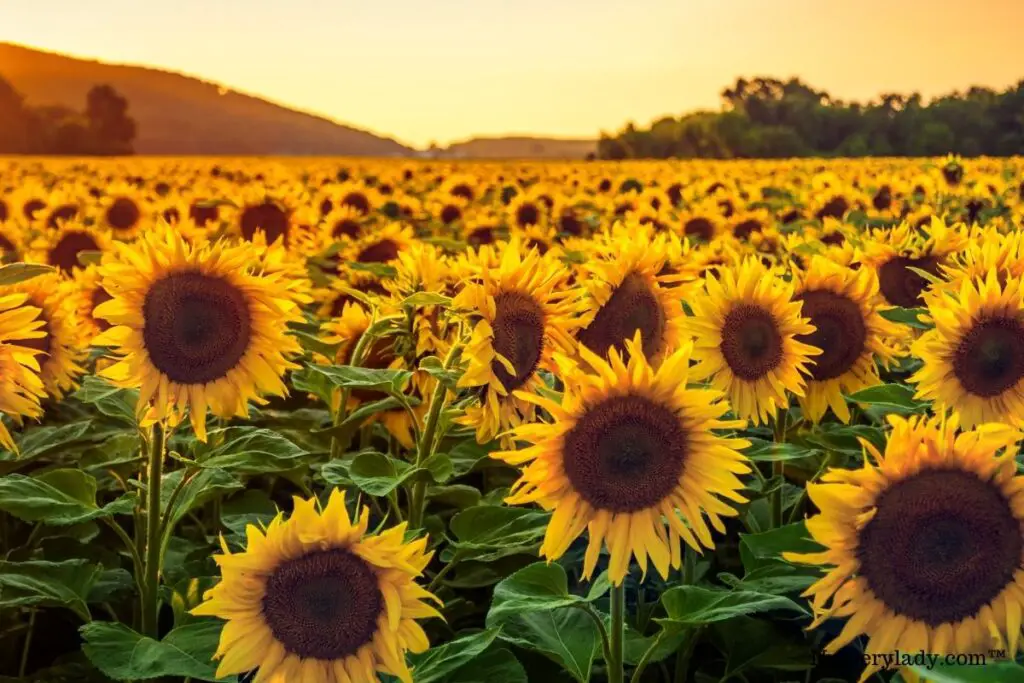
Sunflowers produce bright yellow flowers from summer till fall. Their stems are hardy and a few feet high.
They are known to turn their heads towards the movement of the sun. They grow rapidly and mature in 4 – 5 months.
Light: Sunflowers thrive in full sun; they need 6-8 hours of direct sun for best flowering and growth. In low light, they may not grow abundant flowers and have weak leaves and stems.
Water: Sunflowers can tolerate a few days of dry spells but appreciate a proper watering routine. Keeping the soil evenly moist without keeping it soggy will help the plant bloom better. The drooping plant indicated they needed water.
Fertilizer: Sunflowers are light feeders but will benefit from high phosphorous and potassium fertilizer in the blooming season. If the soil is poor, opt for slow-release fertilizer.
Reference: The University of Minnesota, Kansas State University, BBC Wildlife Magazine, Arizona-Sonora Desert Museum.
